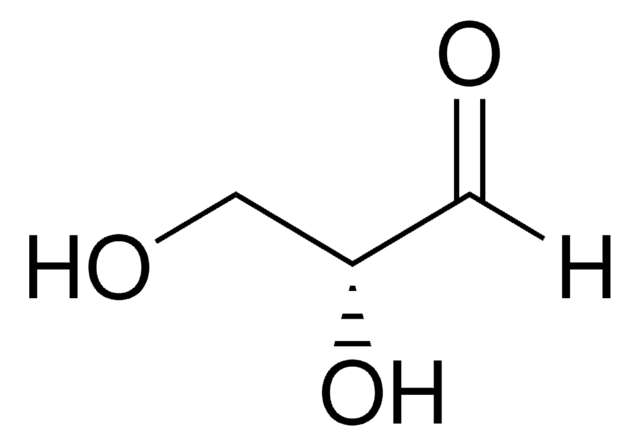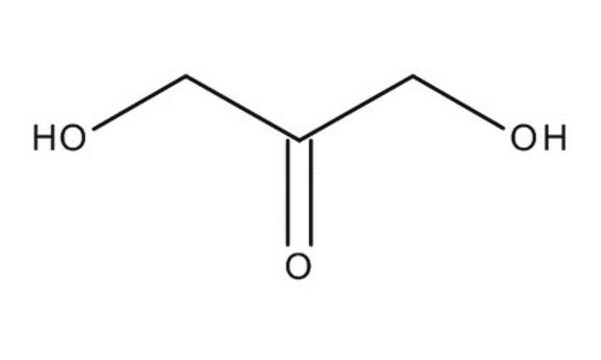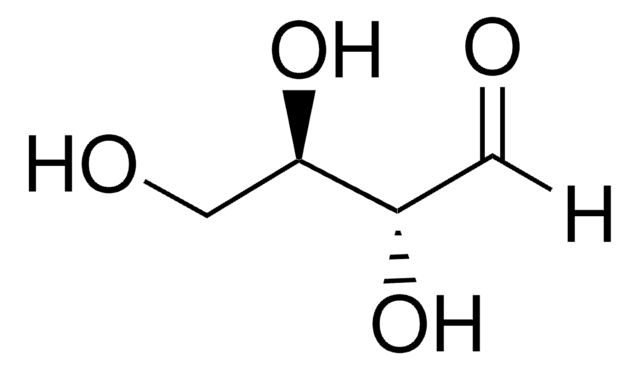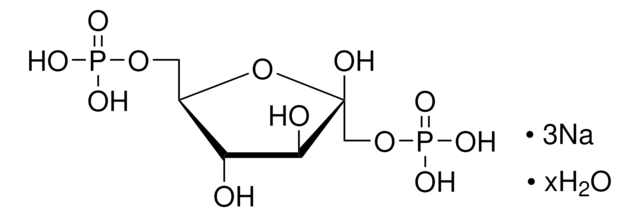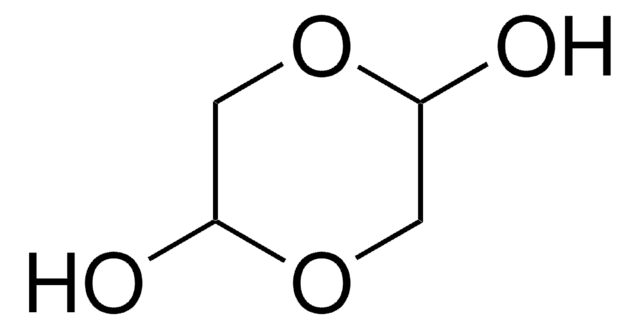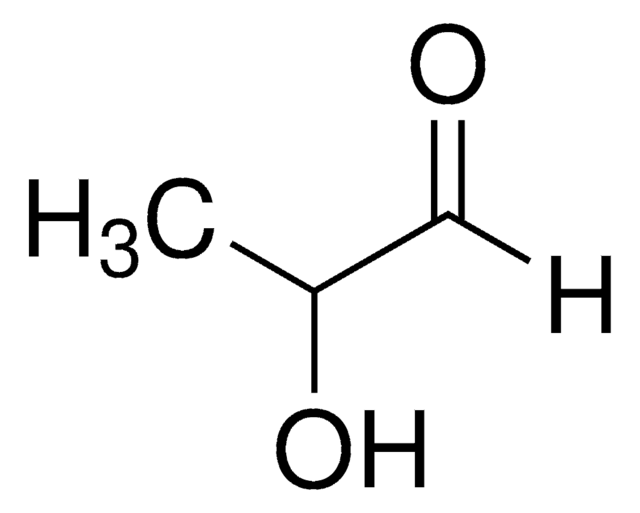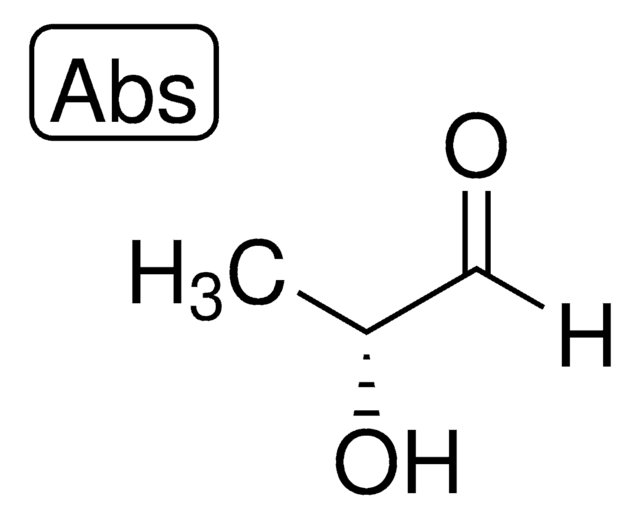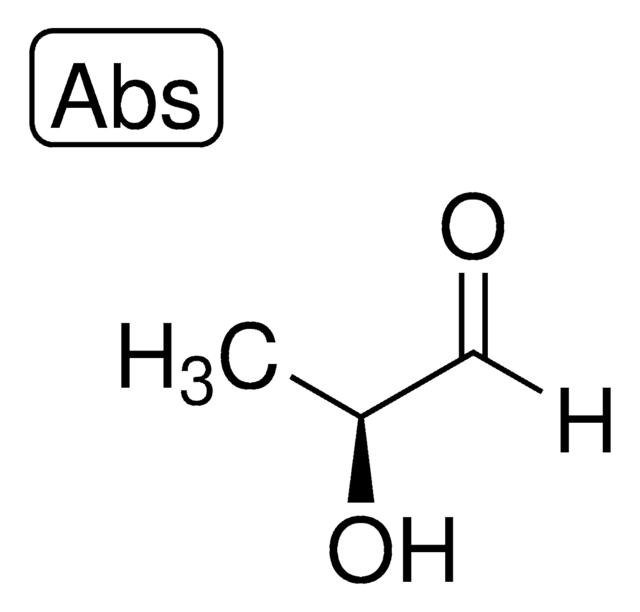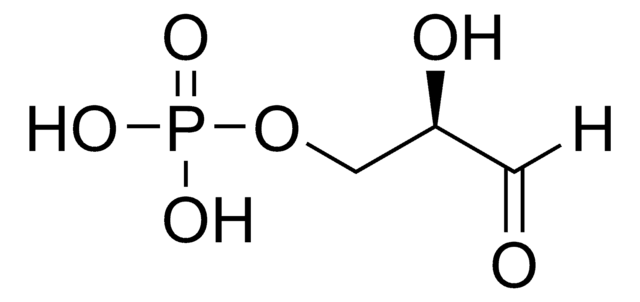Alle Fotos(1)
Wichtige Dokumente
73572
L-(−)-Glycerinaldehyd
≥90% (HPLC)
Synonym(e):
(2S)-2,3-Dihydroxypropanal
Anmeldenzur Ansicht organisationsspezifischer und vertraglich vereinbarter Preise
Alle Fotos(1)
About This Item
Empirische Formel (Hill-System):
C3H6O3
CAS-Nummer:
Molekulargewicht:
90.08
Beilstein:
1720475
EG-Nummer:
MDL-Nummer:
UNSPSC-Code:
12352204
PubChem Substanz-ID:
NACRES:
NA.32
Empfohlene Produkte
Qualitätsniveau
Assay
≥90% (HPLC)
Optische Aktivität
[α]/D -11.0±3.0°, c = 2 in H2O (after 24 h)
Löslichkeit
water: soluble 30 g/L at 18 °C
Lagertemp.
2-8°C
SMILES String
OC[C@H](O)C=O
InChI
1S/C3H6O3/c4-1-3(6)2-5/h1,3,5-6H,2H2/t3-/m1/s1
InChIKey
MNQZXJOMYWMBOU-GSVOUGTGSA-N
Suchen Sie nach ähnlichen Produkten? Aufrufen Leitfaden zum Produktvergleich
Anwendung
- L-Glyceraldehyde Inhibits Neuroblastoma Cell Growth via a Multi-Modal Mechanism on Metabolism and Signaling.: This research highlights the inhibitory effects of L-Glyceraldehyde on neuroblastoma cell growth, revealing its impact through multiple pathways in metabolism and cell signaling (Forbes M et al., 2024).
Biochem./physiol. Wirkung
L-(-)-Glyceraldehyde is an important intermediate in carbohydrate metabolism.
Verpackung
Bottomless glass bottle. Contents are inside inserted fused cone.
Sonstige Hinweise
To gain a comprehensive understanding of our extensive range of Monosaccharides for your research, we encourage you to visit our Carbohydrates Category page.
Lagerklassenschlüssel
10 - Combustible liquids
WGK
WGK 3
Flammpunkt (°F)
233.6 °F - closed cup
Flammpunkt (°C)
112 °C - closed cup
Hier finden Sie alle aktuellen Versionen:
Besitzen Sie dieses Produkt bereits?
In der Dokumentenbibliothek finden Sie die Dokumentation zu den Produkten, die Sie kürzlich erworben haben.
Kunden haben sich ebenfalls angesehen
David A Korasick et al.
Journal of molecular biology, 431(3), 576-592 (2018-12-24)
Heterokonts, Alveolata protists, green algae from Charophyta and Chlorophyta divisions, and all Embryophyta plants possess an aldehyde dehydrogenase (ALDH) gene named ALDH12. Here, we provide a biochemical characterization of two ALDH12 family members from the lower plant Physcomitrella patens and
Nina Richter et al.
Biotechnology and bioengineering, 106(4), 541-552 (2010-03-04)
A whole-cell catalyst using Escherichia coli BL21(DE3) as a host, co-expressing glycerol dehydrogenase (GlyDH) from Gluconobacter oxydans and glucose dehydrogenase (GDH) from Bacillus subtilis for cofactor regeneration, has been successfully constructed and used for the reduction of aliphatic aldehydes, such
Cancer biomarker AKR1B10 and carbonyl metabolism.
Balendiran, G. K., et al.
Chemistry & Biology, 178, 134-137 (2009)
Nina Richter et al.
Chembiochem : a European journal of chemical biology, 10(11), 1888-1896 (2009-07-07)
The acetic acid bacterium Gluconobacter oxydans has a high potential for oxidoreductases with a variety of different catalytic abilities. One putative oxidoreductase gene codes for an enzyme with a high similarity to the NADP+-dependent glycerol dehydrogenase (GlyDH) from Hypocrea jecorina.
Takanori Matsui et al.
Cardiovascular diabetology, 14, 1-1 (2015-01-15)
We have previously shown that serum levels of glyceraldehyde-derived advanced glycation end products (Gly-AGEs) are elevated under oxidative stress and/or diabetic conditions and associated with insulin resistance, endothelial dysfunction and vascular inflammation in humans. Further, Gly-AGEs not only evoke oxidative
Unser Team von Wissenschaftlern verfügt über Erfahrung in allen Forschungsbereichen einschließlich Life Science, Materialwissenschaften, chemischer Synthese, Chromatographie, Analytik und vielen mehr..
Setzen Sie sich mit dem technischen Dienst in Verbindung.